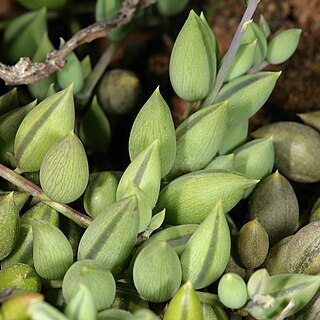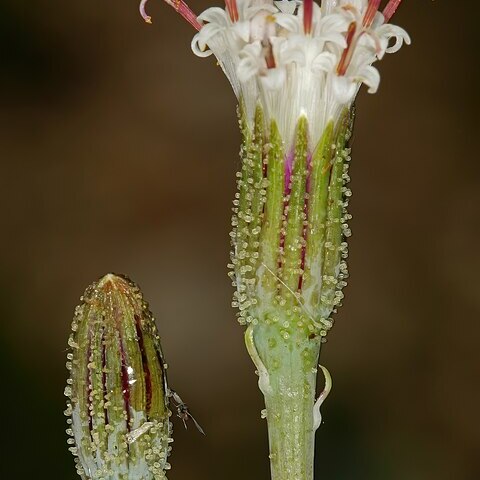Perennial herb; flowering stems up to 150 mm high; procumbent, mat-forming, succulent, leafy, sharply wing-angled from base of each leaf. Leaves: blade fusiform-terete, drying linear-falcate, up to 50 x 9 mm, apex acute, narrowed to short, petiole-like base, glabrous, sometimes with minute sessile glands. Heads discoid, solitary or paired, terminal. Involucral bracts 12-14, 9-14 mm long, shorter than disc florets; calyculus bracts several, short, glabrous but sometimes with sessile glands. Flowers: disc florets only, white; Sep.-Dec., Mar., May. Fruit with cypsela hairy, ± terete, ribbed. Pappus of barbellate bristles.
Succulent perennial, with prostrate or procumbent stems, 1.5-2 mm diam., rooting along their length. Leaves persistent, secund, shortly petiolate, blade ovoid-fusiform, mostly 10-25 x 5-8 mm, glabrous with dorsal window. Flowerheads 1 or 2(3) on terminal, sparsely bracteate peduncles up to 100 mm long, discoid, white or mauve, fragrant; involucre cylindrical, 5-7 mm diam., bracts 10-12, 9-12 x 1-2 mm, glabrous or with short, stout, capitate glands, bracteoles ± 3, subulate.
Glabrous, perennial herb, prostrate, succulent, mat-forming, rooting, leafy. Leaves fusiform, ± sessile, up to 50 x 9 mm, drying ± linear-falcate. Inflorescence on up to 150 mm high, ± nude, erect, terminal peduncles. Capitula 1 or 2, discoid, white; involucre turbinate-campanulate; bracts 12-14, 9-14 mm long; calyculus bracts short, several. Flowering time mainly Mar.-June. Cypselae cylindrical, 3 mm long, ± glabrous.
Prostrate succulent herb. Leaves terete, glabrous. Heads discoid; involucral bracts 12-4.9-14 mm long. Ovaries hairy. Flowers white; October to December and April to June.
Trailing, succulent perennial. Leaves fusiform, secund. Flower heads discoid, solitary or few on sparsely bracteate peduncles to 10 cm, white or mauve, fragrant.


